|
Temperature:
The weather station
is situated about 2 km from the coast on the relatively wide-open
valley floor of the River Otter which is in south east Devon. The
climate here is strongly influenced by the sea preventing extremes
of temperature. During July 2006 whilst the Midlands and south east
England baked in temperatures approaching 38°C (~100°F) the thermometer
here reached a maximum of 30.8°C. This was due to a sea breeze that
regularly reaches here by mid-late morning. It seems that 30°C is
about the limit one could expect even on the hottest of days but
despite this, the humidity remains high and the climate can be
described as quite 'damp' which during hot weather can make it feel
decidedly muggy and sticky.
In the winter time
cold weather is again tempered by the sea and usually preventing any really
severe frosts. Generally frosts are slight
(-0.1°C to -3.0°C) and reasonably infrequent and only occur in calm
conditions under clear skies when katabatic cooling leads to
cold air settling on the valley floor. Some of the higher ground around
here probably only gets a frost once or twice every winter.
Very occasionally
cold air can arrive from the Continent due to a blocking situation
preventing the normal warmth of the Atlantic from reaching here. It
is under these circumstances that temperatures can plummet to very
low levels if there is snow on the ground, such as in January &
December 2010. Even so, ice-days are extremely rare (i.e., when the
temperature remains below freezing all day) and temperatures are
generally higher than those experienced further north and east in
England. Though the majority of winters will be mild and with no
snow such as the winters 2007, 2008, 2011, 2012, 2014, 2015, 2016,
2017 & 2020.
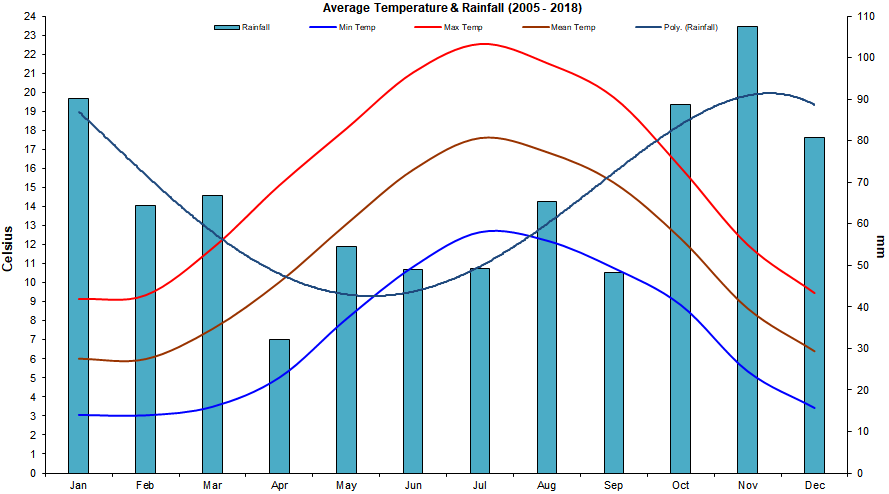
Figure 1. Temperature and rainfall for
the Otter Valley (2005 - 2018)
Precipitation:
There is a definite
drying out of the weather from March through to September with June
& July
being the driest and sunniest months. It can be so dry during the
summer months that drought conditions prevail causing the grass to
go brown all summer long. This is in direct contrast to the winters
which can be so wet that everything remains sopping and
rarely has the chance to dry out. Maximum rainfall occurs during
October to January with a distinct drying trend in precipitation
from late February onwards. Total rainfall for the whole year usually
varies between 700 to 900 mm.
Snow:
A winter can pass
and not one flake of snow will be seen falling, but more often snow will be
seen falling on one or two occasions through the winter and early
spring but it
rarely settles here though December 2010 was exceptional as snow lay
on the ground for 10 consecutive days. The hills on either side of the valley
get a dusting once or twice during the winter time but even here,
the snow will melt quite quickly and often will be gone within a day.
No snow was reported falling or lying at this weather station in the
winters of 2006/07, 2007/08, 2011/12, 2013/14, 2014/15 and 2015/16, no snow
lay on the ground at any time in 2012/13 though was seen falling in
March 2013.
Sunshine:
Being situated near the south coast the Otter Valley has a very
sunny climate when compared to the national average. Yearly sunshine
levels for the last few years have been around 1800 - 1900 hours with the
year 2010 exceeding 2000 hours. This high level of sunshine occurs
mainly on spring and summer days when the wind is from a southerly
direction. It is under these conditions that the sun shines all day
long through a clear blue sky yet just a few more miles inland
cumulus cloud builds from mid-morning onwards turning unbroken
sunshine into sunny spells. January has had the least sunshine since 2007 but you can still expect an average
of 2-3 hours of bright
sunshine daily with totals for the month ranging from 60 - 90 hours.
Sunshine levels reach their peak from May to August with these
months usually getting over 200 hours each. July 2013 had 328
hours of sunshine and so far, is the sunniest month yet recorded.
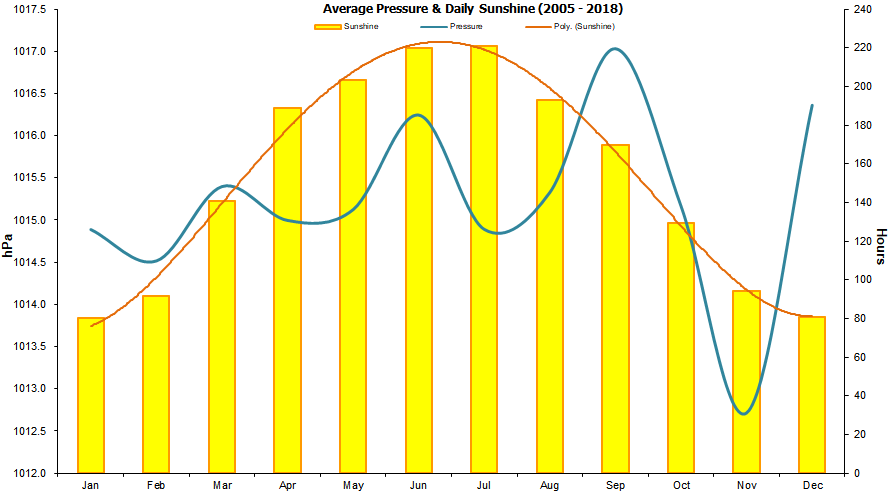
Figure 2. Sunshine and mean pressure for the Otter Valley
(2005 - 2018).
Wind:
Being on a
relatively wide-open valley floor the wind can be quite a feature,
especially when blowing from a southerly direction. Winds from other
directions have hills to deal with so we are quite sheltered to the
west (Dartmoor), north (Blackdown Hills) and east (Fire Beacon). Sea
breezes (from the south) dominate from late March to early September
and that is reflected in the large bias towards the southerly
direction in the radar map below. Land breezes are also common,
especially from late September through to December and these gently
blow from the north on cold, clear nights.
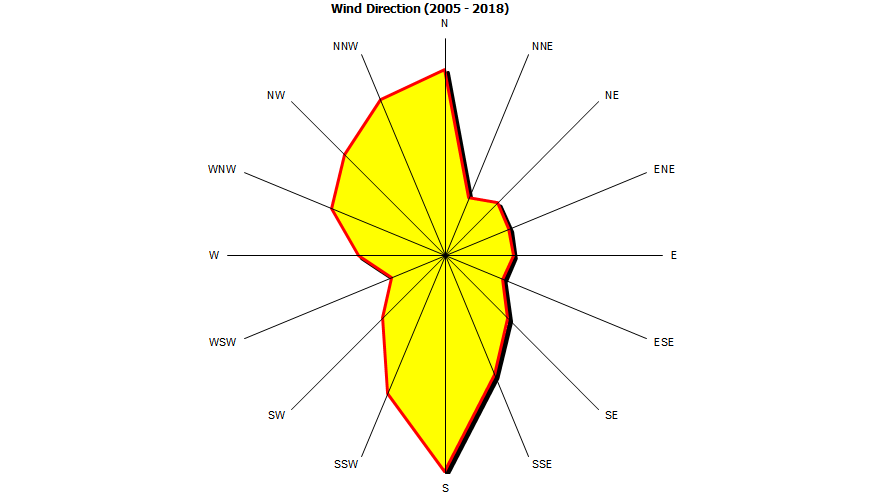
Figure 3. Wind direction for the
Otter Valley (2005 - 2018)
Fog:
In view of the
valley location and dampness of the climate you would have thought
that fog would be more common but I have found that this is not the
case and fog is quite rare here. Rather a different story to the
nearby Exe Valley where fog is more common.
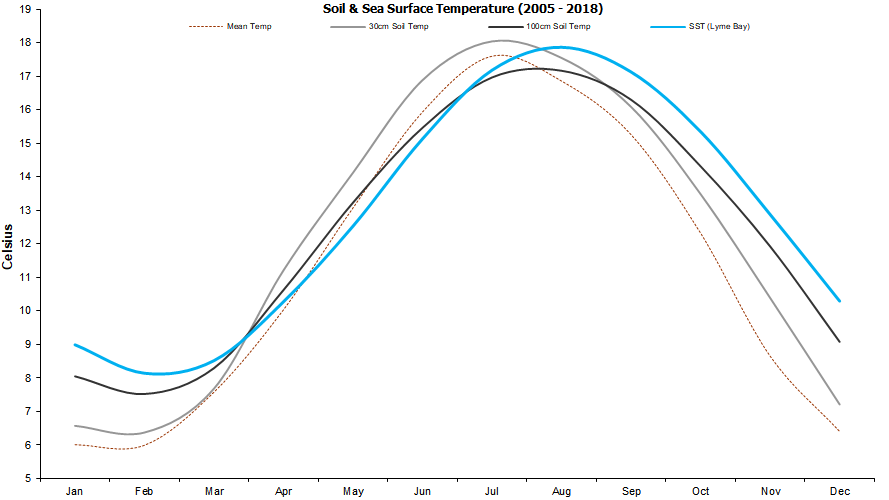
Figure 4. Soil & Sea Surface
Temperatures for the
Otter Valley (2005 - 2018)
Frosts:
Since this station was set up in 2005
there have been no air frosts recorded from May to September, and
only 1 air frost has ever been recorded in October. Air frosts after
mid-April and before November are very infrequent and usually only very slight.
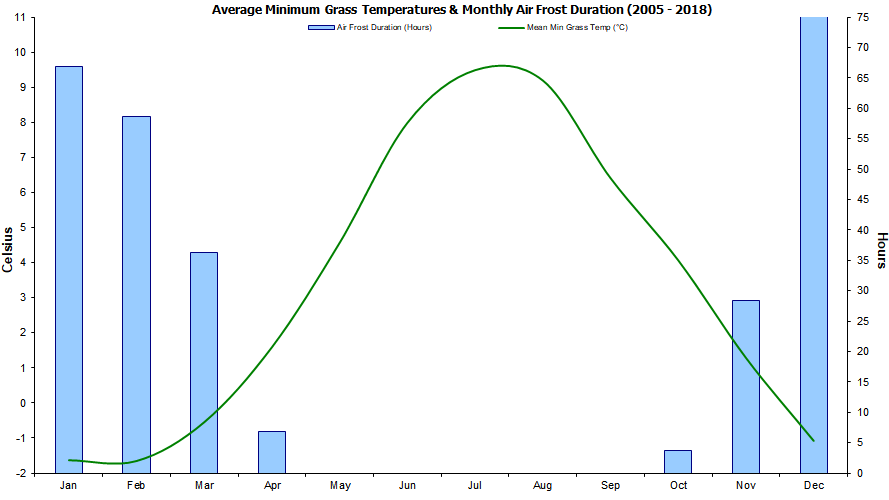
Figure 5. Air frost duration and
mean minimum grass temperatures for the
Otter Valley (2005 - 2018) Seasons:
Being near the south
coast of Devon and on the South West peninsula of England, the
climate here is one of the mildest in the British Isles and Northern
Europe, and strongly
influenced by the North Atlantic which moderates the temperatures
more significantly than places further east and north.
Traditionally the
timing of the seasons are said to follow the equinoxes and
solstices, i.e., winter being the period between 21st December to
March 21st. This may well apply in other parts of the world but here
in the south west of England this timing of the seasons has little
meaning. Meteorologically the seasons are better defined as Winter =
Dec, Jan & Feb; Spring = Mar, Apr & May and so on. This divides the
year up into nice, equal parts and is useful for weather recording
but is a generalisation for the whole of the British Isles where the
climate of northern Scotland is a world away from the climate here
in the Otter Valley.
Here are my
'generalisations' for the seasons here in the Otter Valley and they
roughly follow the cycles of natural world around us:
Winter (Dec -
mid-February): Somebody once told me that down here in the South
West you only get what he termed was a 'pseudo-winter'. I
have a tendency to agree. Even though I call December a winter month
the sea is still so warm that days with a maximum below 10°C do not
dominate
until January (December 2010 was an exception!). Another person said that there is always a touch of
spring in a Devon winter, and I think that is the best way to
describe the months of December, January & February. The trees may
be without leaves from mid-December onwards but you will still find
a Herb Robert and primroses flowering in the woods and hedgerows in
January and February where there is south-facing shelter.
Spring
(mid-February - mid-May):
Spring comes early to the Otter Valley and by mid-February nature
seems be getting prepared. The dawn chorus is becoming very
noticeable now, as is the lengthening of the day. Wild daffodils,
3-cornered Leeks and snowdrops will be in flower before the end of
February and by early March the hawthorn and willow will be coming into
leaf. By April the Devon Bank hedgerows are bursting into life with
a mass of wildflowers and the fields turn yellow with buttercups and
dandelions. At the end of April most of the trees will be in full
leaf though the ash is always a late starter.
Summer (mid-May -
mid-September): By mid-May
the countryside has taken on its summer look with all the trees now
in full, dark green leaf and will stay that way until well into the
autumn.
Autumn
(mid-September - November):
Autumn feels like the shortest season, but due to the warmth of the
sea it can stay surprisingly warm and October often produces
summer-like days down on the beach. Air frosts are rare in October
and usually do not appear until after mid-November. |